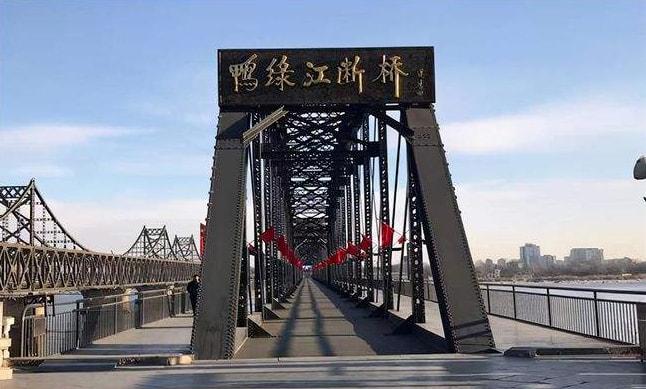Let's look at this set of data. During the Period of the War to Resist US Aggression and Aid Korea, the railway corps engineers of our army rushed to repair bridges more than 2,290 times and repaired highway bridges 1,197 times. More than 385,000 vehicles of materials and troops were transported by rail, and more than 4.8 million tons of various materials were transported, which effectively guaranteed the victory of front-line operations.
In the war, it is common for both sides to blow up bridges and repair bridges, so in the Korean War, both China and the United States experienced several times to blow up bridges. I looked at Li Feng's book "Decisive Battle of Korea" and found that there are seven major bridge battles, so let's take a look at it together.
The first is the Yalu River Bridge
The first U.S. bombing of the Yalu River Bridge was on November 8, 1950, which caused the bridge to be broken and the steel beams on the North Korean side fell into the water. The second time was on 14 November, which resulted in the destruction of the piers. But that didn't stop the volunteers from entering North Korea. On the one hand, the engineers carried out repairs, and on the other hand, a large number of pontoon bridges were erected to ensure the transportation of personnel and equipment.
The second is the three-blown Watergate Bridge
This is the wonderful story told by the movie "Watergate Bridge" in Chosin Lake. The Pratunam Bridge is actually a dam, only 8 .8m long, once the bridge is broken, the infantry can pass, but all the heavy equipment needs to be thrown away, so the importance of this bridge is very clear to everyone.
The Volunteers had blown up three times in the past. Once on December 1, again on December 4, and again on December 6 for the third time. The third time it was the most severely blown up, and the entire bridge was almost scrapped, but the US army actually repaired it again with strong logistical support capabilities, allowing the First Marine Division to escape smoothly.
The third is the Datong River Bridge
Datong River is a key location on our transport lines. Choked the throat of the East End transport. In August 1951, the bridge was destroyed by an American air raid and was successfully reopened to traffic nine days later. Considering that a bridge cannot ensure the normal transportation of materials, the troops on the one hand enhance the anti-bombing ability of the bridge, and on the other hand, build several more bridges nearby. In this way, a transport line based on the Datong River Bridge was formed, and with the addition of three convenient bridges, it was almost impossible for the enemy to blow up four bridges at the same time.
The fourth is the Cheongcheon River Bridge
Since May 1951, the U.S. military has been bombing the Cheongcheon River Bridge, resulting in a large number of military materials stranded. The supply of materials ahead can only last for three or four days, and the consequences of not repairing the bridge quickly are unimaginable. In an emergency, the ascending hero Yang Liandi and his comrades fought all night, building the pontoon bridge 12 times, and finally restored the Cheongcheon River Bridge to traffic.
The fifth is the surprise attack on Wuling Bridge
The war correspondent Li Feng's book "Decisive Battle of Korea" tells the story of the surprise attack on wuling bridge. Unlike the movie "Raid", the real history is that there is not only a platoon of troops, but a detachment of 323 people, carrying 600kg of explosives and sufficient weapons and ammunition. After a short battle, the enemy troops guarding the bridge were eliminated and the bridge was blown up at 7:50 on November 26.
The sixth Place Bailingchuan Bridge
The Bailingchuan Bridge has attracted the attention of the US Air Force because of its dangerous terrain and difficulty in repairing it. On February 9, 1952, the U.S. military conducted 26 air raids on the Bailingchuan Bridge, dropping 7,000 bombs. The commanders and fighters of the Ninth Company of the Third Battalion of the Railway Corps ensured the opening of this throat bridge at the cost of 99 casualties, and the soldier Yuan Wen still insisted on the front line of building the bridge after his legs were blown off, and he sacrificed himself heroically. The successful restoration of the Bailingchuan Bridge directly guaranteed the victory of the Battle of Shangganling.
The seventh is the Kongo River Bridge
"Decisive Battle of Korea" records that because the US military blew up the bridge, the volunteer command demanded that the bridge be repaired within eight days. Since May 1953, a company of volunteer engineers has been fighting day and night on the Kumgang River Bridge. The US military planes continued to bomb and drop more than a thousand bombs, but the Kongo River Bridge always stood there. Since the fighting around the Kumgang River Bridge lasted until the armistice was signed, it was also the last bridge to be bombed.
